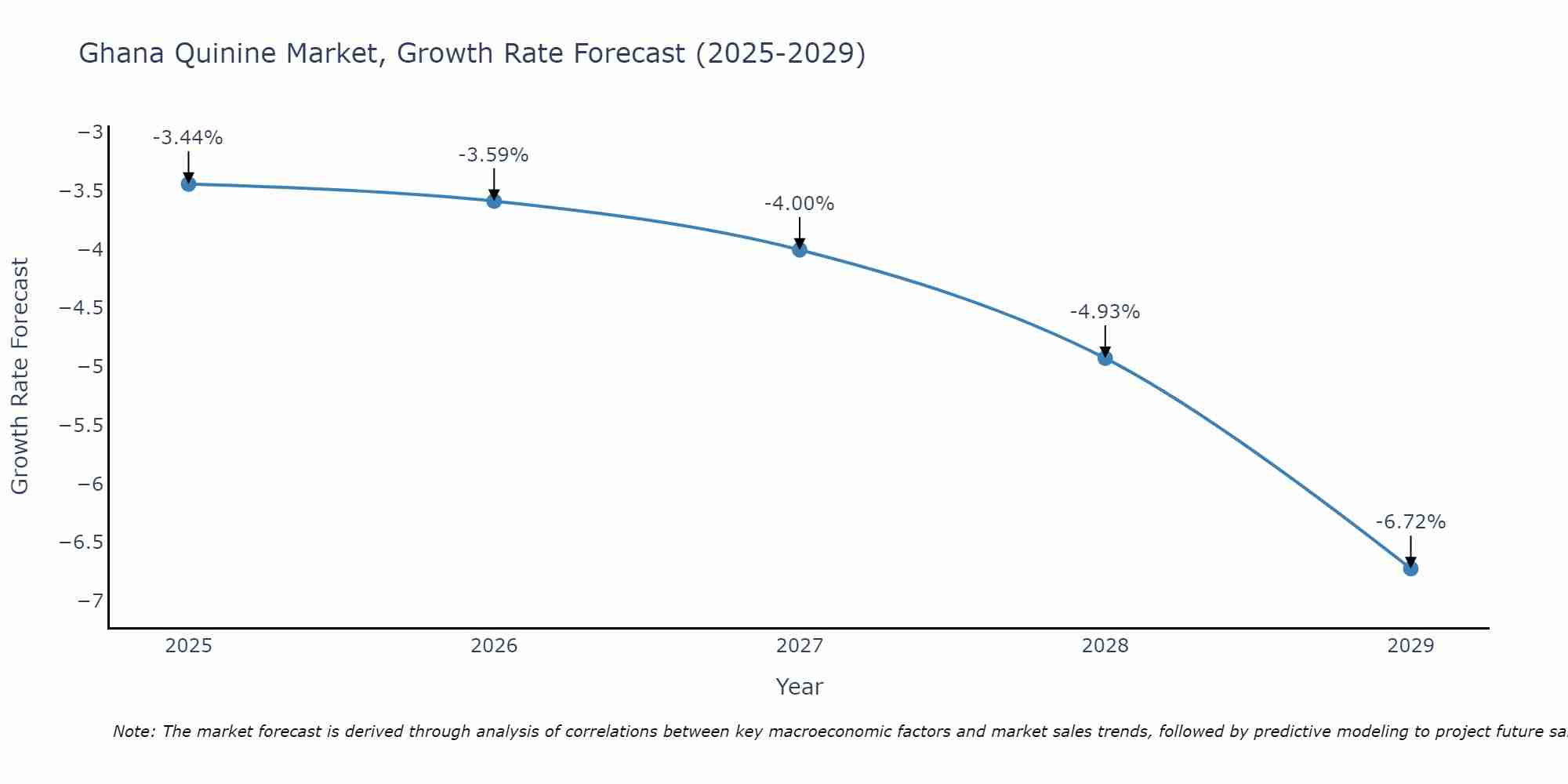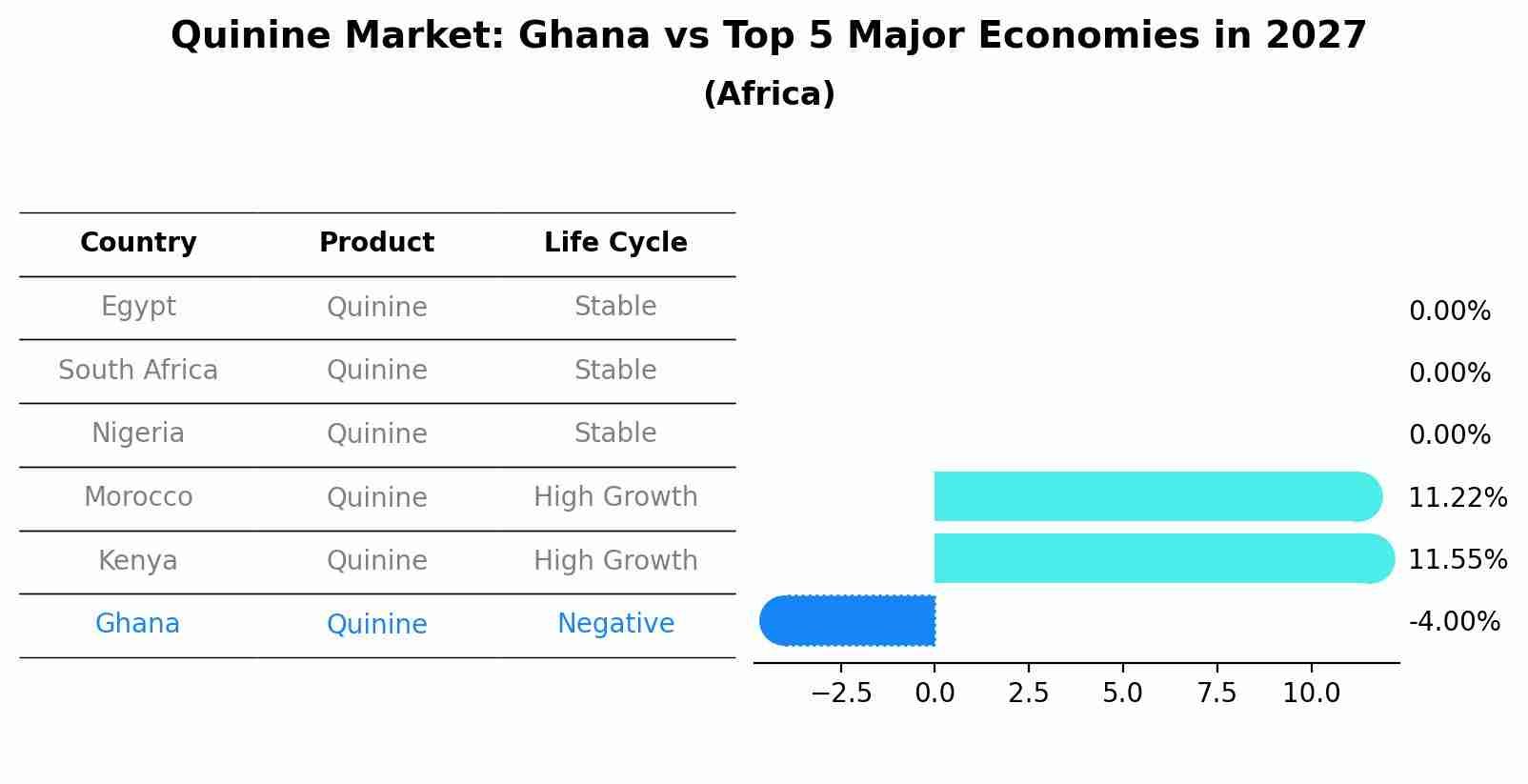Ghana Quinine Market (2025-2031) Outlook | Industry, Size, Companies, Share, Value, Revenue, Growth, Forecast, Analysis & Trends
| Product Code: ETC343736 | Publication Date: Aug 2022 | Updated Date: Aug 2025 | Product Type: Market Research Report | |
| Publisher: 6Wresearch | Author: Shubham Padhi | No. of Pages: 75 | No. of Figures: 35 | No. of Tables: 20 |
Ghana Quinine Market Size Growth Rate
The Ghana Quinine Market could see a tapering of growth rates over 2025 to 2029. Although the growth rate starts strong at -3.44% in 2025, it steadily loses momentum, ending at -6.72% by 2029.

Quinine Market: Ghana vs Top 5 Major Economies in 2027 (Africa)
Ghana's Quinine market is anticipated to experience a negative growth rate of -4.00% by 2027, reflecting trends observed in the largest economy Egypt, followed by South Africa, Nigeria, Morocco and Kenya.

Ghana Quinine Market Overview
The quinine market in Ghana involves the production and distribution of quinine, a natural alkaloid used in pharmaceuticals for treating malaria and as a flavoring agent in beverages such as tonic water.
Drivers of the market
The increasing prevalence of malaria, the growing demand for antimalarial drugs, and the adoption of quinine for its efficacy and affordability are driving the growth of Ghana quinine market. Quinine, derived from the bark of the cinchona tree, is used for the treatment of malaria and other febrile illnesses, supporting disease management and market growth.
Challenges of the market
The Ghana Quinine Market faces challenges such as limited availability of natural sources of quinine, regulatory restrictions on its use due to potential side effects, and competition from synthetic alternatives in the pharmaceutical industry.
Government Policy of the market
Recognizing the medicinal value of quinine in treating malaria and other diseases, the government of Ghana has implemented policies to regulate and support the production and distribution of quinine-based pharmaceutical products. These policies aim to ensure compliance with quality and safety standards in quinine extraction and formulation, promote sustainable quinine sourcing practices, and enhance access to affordable quinine-based medicines for patients across the country. Additionally, the government emphasizes the importance of promoting research and development in quinine derivatives and alternative antimalarial therapies, supporting local pharmaceutical manufacturers in producing high-quality quinine products, and fostering partnerships with international health organizations and drug manufacturers. By fostering a conducive regulatory environment and providing support for innovation and investment, the government seeks to enhance the availability and affordability of quinine-based medicines in Ghana.
Key Highlights of the Report:
- Ghana Quinine Market Outlook
- Market Size of Ghana Quinine Market, 2024
- Forecast of Ghana Quinine Market, 2031
- Historical Data and Forecast of Ghana Quinine Revenues & Volume for the Period 2021-2031
- Ghana Quinine Market Trend Evolution
- Ghana Quinine Market Drivers and Challenges
- Ghana Quinine Price Trends
- Ghana Quinine Porter's Five Forces
- Ghana Quinine Industry Life Cycle
- Historical Data and Forecast of Ghana Quinine Market Revenues & Volume By Mode of Administration for the Period 2021-2031
- Historical Data and Forecast of Ghana Quinine Market Revenues & Volume By Oral Administration for the Period 2021-2031
- Historical Data and Forecast of Ghana Quinine Market Revenues & Volume By Intravenous Administration for the Period 2021-2031
- Historical Data and Forecast of Ghana Quinine Market Revenues & Volume By Intramuscular Administration for the Period 2021-2031
- Historical Data and Forecast of Ghana Quinine Market Revenues & Volume By Others for the Period 2021-2031
- Historical Data and Forecast of Ghana Quinine Market Revenues & Volume By Application for the Period 2021-2031
- Historical Data and Forecast of Ghana Quinine Market Revenues & Volume By Antimalarial for the Period 2021-2031
- Historical Data and Forecast of Ghana Quinine Market Revenues & Volume By Antipyretic for the Period 2021-2031
- Historical Data and Forecast of Ghana Quinine Market Revenues & Volume By Others for the Period 2021-2031
- Historical Data and Forecast of Ghana Quinine Market Revenues & Volume By End-user for the Period 2021-2031
- Historical Data and Forecast of Ghana Quinine Market Revenues & Volume By Hospitals for the Period 2021-2031
- Historical Data and Forecast of Ghana Quinine Market Revenues & Volume By Clinics for the Period 2021-2031
- Historical Data and Forecast of Ghana Quinine Market Revenues & Volume By Ambulatory Surgical Centers for the Period 2021-2031
- Historical Data and Forecast of Ghana Quinine Market Revenues & Volume By Others for the Period 2021-2031
- Ghana Quinine Import Export Trade Statistics
- Market Opportunity Assessment By Mode of Administration
- Market Opportunity Assessment By Application
- Market Opportunity Assessment By End-user
- Ghana Quinine Top Companies Market Share
- Ghana Quinine Competitive Benchmarking By Technical and Operational Parameters
- Ghana Quinine Company Profiles
- Ghana Quinine Key Strategic Recommendations
Frequently Asked Questions About the Market Study (FAQs):
1 Executive Summary |
2 Introduction |
2.1 Key Highlights of the Report |
2.2 Report Description |
2.3 Market Scope & Segmentation |
2.4 Research Methodology |
2.5 Assumptions |
3 Ghana Quinine Market Overview |
3.1 Ghana Country Macro Economic Indicators |
3.2 Ghana Quinine Market Revenues & Volume, 2021 & 2031F |
3.3 Ghana Quinine Market - Industry Life Cycle |
3.4 Ghana Quinine Market - Porter's Five Forces |
3.5 Ghana Quinine Market Revenues & Volume Share, By Mode of Administration, 2021 & 2031F |
3.6 Ghana Quinine Market Revenues & Volume Share, By Application, 2021 & 2031F |
3.7 Ghana Quinine Market Revenues & Volume Share, By End-user, 2021 & 2031F |
4 Ghana Quinine Market Dynamics |
4.1 Impact Analysis |
4.2 Market Drivers |
4.2.1 Increasing awareness about the health benefits of quinine in Ghana |
4.2.2 Growing demand for natural and herbal remedies in the country |
4.2.3 Rising prevalence of malaria and other mosquito-borne diseases in Ghana |
4.3 Market Restraints |
4.3.1 Price fluctuations of quinine in the global market |
4.3.2 Regulatory challenges related to the use and import of quinine in Ghana |
4.3.3 Competition from alternative treatments and medications |
5 Ghana Quinine Market Trends |
6 Ghana Quinine Market, By Types |
6.1 Ghana Quinine Market, By Mode of Administration |
6.1.1 Overview and Analysis |
6.1.2 Ghana Quinine Market Revenues & Volume, By Mode of Administration, 2021-2031F |
6.1.3 Ghana Quinine Market Revenues & Volume, By Oral Administration, 2021-2031F |
6.1.4 Ghana Quinine Market Revenues & Volume, By Intravenous Administration, 2021-2031F |
6.1.5 Ghana Quinine Market Revenues & Volume, By Intramuscular Administration, 2021-2031F |
6.1.6 Ghana Quinine Market Revenues & Volume, By Others, 2021-2031F |
6.2 Ghana Quinine Market, By Application |
6.2.1 Overview and Analysis |
6.2.2 Ghana Quinine Market Revenues & Volume, By Antimalarial, 2021-2031F |
6.2.3 Ghana Quinine Market Revenues & Volume, By Antipyretic, 2021-2031F |
6.2.4 Ghana Quinine Market Revenues & Volume, By Others, 2021-2031F |
6.3 Ghana Quinine Market, By End-user |
6.3.1 Overview and Analysis |
6.3.2 Ghana Quinine Market Revenues & Volume, By Hospitals, 2021-2031F |
6.3.3 Ghana Quinine Market Revenues & Volume, By Clinics, 2021-2031F |
6.3.4 Ghana Quinine Market Revenues & Volume, By Ambulatory Surgical Centers, 2021-2031F |
6.3.5 Ghana Quinine Market Revenues & Volume, By Others, 2021-2031F |
7 Ghana Quinine Market Import-Export Trade Statistics |
7.1 Ghana Quinine Market Export to Major Countries |
7.2 Ghana Quinine Market Imports from Major Countries |
8 Ghana Quinine Market Key Performance Indicators |
8.1 Number of malaria cases reported in Ghana annually |
8.2 Percentage of population using herbal remedies for healthcare in Ghana |
8.3 Investment in healthcare infrastructure and facilities in Ghana to combat diseases |
9 Ghana Quinine Market - Opportunity Assessment |
9.1 Ghana Quinine Market Opportunity Assessment, By Mode of Administration, 2021 & 2031F |
9.2 Ghana Quinine Market Opportunity Assessment, By Application, 2021 & 2031F |
9.3 Ghana Quinine Market Opportunity Assessment, By End-user, 2021 & 2031F |
10 Ghana Quinine Market - Competitive Landscape |
10.1 Ghana Quinine Market Revenue Share, By Companies, 2024 |
10.2 Ghana Quinine Market Competitive Benchmarking, By Operating and Technical Parameters |
11 Company Profiles |
12 Recommendations |
13 Disclaimer |
- Single User License$ 1,995
- Department License$ 2,400
- Site License$ 3,120
- Global License$ 3,795
Search
Thought Leadership and Analyst Meet
Our Clients
Related Reports
- Canada Oil and Gas Market (2026-2032) | Share, Segmentation, Value, Industry, Trends, Forecast, Analysis, Size & Revenue, Growth, Competitive Landscape, Outlook, Companies
- Germany Breakfast Food Market (2026-2032) | Industry, Share, Growth, Size, Companies, Value, Analysis, Revenue, Trends, Forecast & Outlook
- Australia Briquette Market (2025-2031) | Growth, Size, Revenue, Forecast, Analysis, Trends, Value, Share, Industry & Companies
- Vietnam System Integrator Market (2025-2031) | Size, Companies, Analysis, Industry, Value, Forecast, Growth, Trends, Revenue & Share
- ASEAN and Thailand Brain Health Supplements Market (2025-2031) | Strategy, Consumer Insights, Analysis, Investment Trends, Opportunities, Growth, Size, Share, Industry, Revenue, Segments, Value, Segmentation, Supply, Forecast, Restraints, Outlook, Competition, Drivers, Trends, Demand, Pricing Analysis, Competitive, Strategic Insights, Companies, Challenges
- ASEAN Bearings Market (2025-2031) | Strategy, Consumer Insights, Analysis, Investment Trends, Opportunities, Growth, Size, Share, Industry, Revenue, Segments, Value, Segmentation, Supply, Forecast, Restraints, Outlook, Competition, Drivers, Trends, Demand, Pricing Analysis, Competitive, Strategic Insights, Companies, Challenges
- Europe Flooring Market (2025-2031) | Outlook, Share, Industry, Trends, Forecast, Companies, Revenue, Size, Analysis, Growth & Value
- Saudi Arabia Manlift Market (2025-2031) | Outlook, Size, Growth, Trends, Companies, Industry, Revenue, Value, Share, Forecast & Analysis
- Uganda Excavator, Crane, and Wheel Loaders Market (2025-2031) | Strategy, Consumer Insights, Analysis, Investment Trends, Opportunities, Growth, Size, Share, Industry, Revenue, Segments, Value, Segmentation, Supply, Forecast, Restraints, Outlook, Competition, Drivers, Trends, Demand, Pricing Analysis, Competitive, Strategic Insights, Companies, Challenges
- Rwanda Excavator, Crane, and Wheel Loaders Market (2025-2031) | Strategy, Consumer Insights, Analysis, Investment Trends, Opportunities, Growth, Size, Share, Industry, Revenue, Segments, Value, Segmentation, Supply, Forecast, Restraints, Outlook, Competition, Drivers, Trends, Demand, Pricing Analysis, Competitive, Strategic Insights, Companies, Challenges
Industry Events and Analyst Meet
Whitepaper
- Middle East & Africa Commercial Security Market Click here to view more.
- Middle East & Africa Fire Safety Systems & Equipment Market Click here to view more.
- GCC Drone Market Click here to view more.
- Middle East Lighting Fixture Market Click here to view more.
- GCC Physical & Perimeter Security Market Click here to view more.
6WResearch In News
- Doha a strategic location for EV manufacturing hub: IPA Qatar
- Demand for luxury TVs surging in the GCC, says Samsung
- Empowering Growth: The Thriving Journey of Bangladesh’s Cable Industry
- Demand for luxury TVs surging in the GCC, says Samsung
- Video call with a traditional healer? Once unthinkable, it’s now common in South Africa
- Intelligent Buildings To Smooth GCC’s Path To Net Zero


















